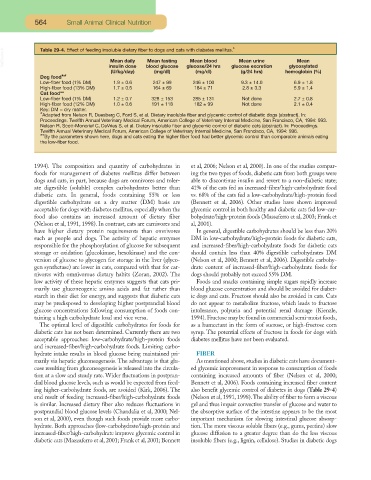Page 545 - Small Animal Clinical Nutrition 5th Edition
P. 545
564 Small Animal Clinical Nutrition
VetBooks.ir Table 29-4. Effect of feeding insoluble dietary fiber to dogs and cats with diabetes mellitus.* Mean urine Mean
Mean daily
Mean blood
Mean fasting
glycosylated
insulin dose
(mg/dl)
(mg/dl)
(g/24 hrs)
(U/kg/day) blood glucose glucose/24 hrs glucose excretion hemoglobin (%)
Dog food**
Low-fiber food (1% DM) 1.9 ± 0.6 247 ± 99 246 ± 100 9.3 ± 14.0 6.9 ± 1.8
High-fiber food (13% DM) 1.7 ± 0.5 164 ± 69 184 ± 71 2.8 ± 3.3 5.9 ± 1.4
Cat food**
Low-fiber food (1% DM) 1.2 ± 0.7 328 ± 153 285 ± 131 Not done 2.7 ± 0.8
High-fiber food (12% DM) 1.0 ± 0.6 191 ± 118 182 ± 99 Not done 2.1 ± 0.4
Key: DM = dry matter.
*Adapted from Nelson R, Duesberg C, Ford S, et al. Dietary insoluble fiber and glycemic control of diabetic dogs (abstract). In:
Proceedings. Twelfth Annual Veterinary Medical Forum, American College of Veterinary Internal Medicine, San Francisco, CA, 1994: 993.
Nelson R, Scott-Moncrief C, DeVries S, et al. Dietary insoluble fiber and glycemic control of diabetic cats (abstract). In: Proceedings.
Twelfth Annual Veterinary Medical Forum, American College of Veterinary Internal Medicine, San Francisco, CA, 1994: 996.
**By the parameters shown here, dogs and cats eating the higher fiber food had better glycemic control than comparable animals eating
the low-fiber food.
1994). The composition and quantity of carbohydrates in et al, 2006; Nelson et al, 2000). In one of the studies compar-
foods for management of diabetes mellitus differ between ing the two types of foods, diabetic cats from both groups were
dogs and cats, in part, because dogs are omnivores and toler- able to discontinue insulin and revert to a non-diabetic state;
ate digestible (soluble) complex carbohydrates better than 41% of the cats fed an increased-fiber/high-carbohydrate food
diabetic cats. In general, foods containing 55% or less vs. 68% of the cats fed a low-carbohydrate/high-protein food
digestible carbohydrate on a dry matter (DM) basis are (Bennett et al, 2006). Other studies have shown improved
acceptable for dogs with diabetes mellitus, especially when the glycemic control in both healthy and diabetic cats fed low-car-
food also contains an increased amount of dietary fiber bohydrate/high-protein foods (Massaferro et al, 2003; Frank et
(Nelson et al, 1991, 1998). In contrast, cats are carnivores and al, 2001).
have higher dietary protein requirements than omnivores In general, digestible carbohydrates should be less than 20%
such as people and dogs. The activity of hepatic enzymes DM in low-carbohydrate/high-protein foods for diabetic cats,
responsible for the phosphorylation of glucose for subsequent and increased-fiber/high-carbohydrate foods for diabetic cats
storage or oxidation (glucokinase, hexokinase) and the con- should contain less than 40% digestible carbohydrates DM
version of glucose to glycogen for storage in the liver (glyco- (Nelson et al, 2000; Bennett et al, 2006). Digestible carbohy-
gen synthetase) are lower in cats, compared with that for car- drate content of increased-fiber/high-carbohydrate foods for
nivores with omnivorous dietary habits (Zoran, 2002). The dogs should probably not exceed 55% DM.
low activity of these hepatic enzymes suggests that cats pri- Foods and snacks containing simple sugars rapidly increase
marily use gluconeogenic amino acids and fat rather than blood glucose concentration and should be avoided for diabet-
starch in their diet for energy, and suggests that diabetic cats ic dogs and cats. Fructose should also be avoided in cats. Cats
may be predisposed to developing higher postprandial blood do not appear to metabolize fructose, which leads to fructose
glucose concentrations following consumption of foods con- intolerance, polyuria and potential renal damage (Kienzle,
taining a high carbohydrate load and vice versa. 1994). Fructose may be found in commercial semi-moist foods,
The optimal level of digestible carbohydrates for foods for as a humectant in the form of sucrose, or high-fructose corn
diabetic cats has not been determined. Currently there are two syrup. The potential effects of fructose in foods for dogs with
acceptable approaches: low-carbohydrate/high-protein foods diabetes mellitus have not been evaluated.
and increased-fiber/high-carbohydrate foods. Limiting carbo-
hydrate intake results in blood glucose being maintained pri- FIBER
marily via hepatic gluconeogenesis. The advantage is that glu- As mentioned above, studies in diabetic cats have document-
cose resulting from gluconeogenesis is released into the circula- ed glycemic improvement in response to consumption of foods
tion at a slow and steady rate. Wider fluctuations in postpran- containing increased amounts of fiber (Nelson et al, 2000;
dial blood glucose levels, such as would be expected from feed- Bennett et al, 2006). Foods containing increased fiber content
ing higher-carbohydrate foods, are avoided (Kirk, 2006). The also benefit glycemic control of diabetes in dogs (Table 29-4)
end result of feeding increased-fiber/high-carbohydrate foods (Nelson et al, 1991, 1998).The ability of fiber to form a viscous
is similar. Increased dietary fiber also reduces fluctuations in gel and thus impair convective transfer of glucose and water to
postprandial blood glucose levels (Chandalia et al, 2000; Nel- the absorptive surface of the intestine appears to be the most
son et al, 2000), even though such foods provide more carbo- important mechanism for slowing intestinal glucose absorp-
hydrate. Both approaches (low-carbohydrate/high-protein and tion. The more viscous soluble fibers (e.g., gums, pectins) slow
increased-fiber/high-carbohydrate improve glycemic control in glucose diffusion to a greater degree than do the less viscous
diabetic cats (Mazzaferro et al, 2001; Frank et al, 2001; Bennett insoluble fibers (e.g., lignin, cellulose). Studies in diabetic dogs

